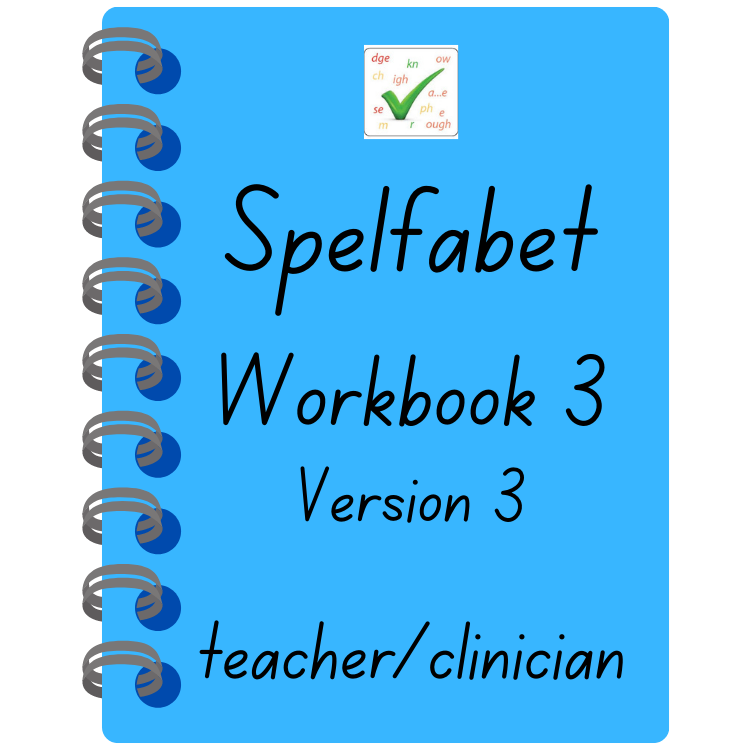Workbook 3 version 3 – teacher/clinician
$AUD30.00
This workbook teaches the ‘split’ or ‘e-controlled’ vowel spellings a…e as in ‘take’, e…e as in ‘theme’, i…e as in ‘time’, o…e as in ‘hope’, and u…e as in ‘cute’ and ‘June’, and contrasts these with ‘short’ vowels learnt to date. It also introduces ee as in ‘see’, c as in ‘cent’, g as in ‘age’, u as in ‘put’, oo as in ‘good’, oo as in ‘food’, o as in ‘other’, y as in ‘my’ and ‘baby’, and single letter ‘long’ vowel spellings, as in ‘taking’, ‘thematic’, ‘timing’, ‘going’, ‘bluish’ and ‘tuning’.
Many struggling readers find the idea of one letter being able to represent more than one sound very hard, and need to be taught to think flexibly and look for doubled consonants and ck, which help us identify the vowel sound. This book also introduces prefixes and one additional suffix.
Description
This 2021 download-and-print workbook introduces the ‘long’ vowel sounds and their most common spellings (e.g. a…e as in ‘take’, a as in ‘taking’) and contrasts them with the ‘short’ vowels typically spelt with the same vowel letter (e.g. a as in tack). It shows how doubled consonants and ‘ck’ signal how to pronounce the preceding vowel (e.g. tapping-taping, licking-liking, supper-super). See full contents page below.
The book’s 104 pages of activities show how ‘short’ and ‘long’ vowels sometimes occur in related words e.g. ‘kept/keep’ and ‘study/student’. There are activities to teach flexible thinking about how letters can represent more than one sound (e.g. the ‘o’ in ‘poster’ and ‘roster), and manipulate phonemes in words. The letter ‘y’ is included as a major vowel spelling (y as in ‘dry’, y as in ‘baby’).
This book also introduces letter c as in ‘ace’ and letter g as in ‘age’, the vowel sound in ‘put’ and ‘good’, and the spelling ‘o’ as in ‘son’, as it is in many high-frequency words. Some prefixes/common initial syllables (e.g. be, re, in, dis, con) are introduced, as well as the suffix ‘ify’ as in ‘simplify’.
The 104 pages of activities are in pairs, allowing learners to copy words or syllables into sentences on one page, read the completed sentences, then write them from dictation on the second page. All the sentences are on a cheat sheet for supporting adults at the back of the book, and contain only spelling patterns that have already been taught in this workbook series. The file pictures are in colour, but the books can be printed in black-and-white if you prefer.
The Dandelion Split Vowel Spellings books for young children include many of the vowel spellings covered in this book.
This book was designed by a Speech Pathologist to be easy for parents and aides to support. Up to 30 copies of this workbook may be made. If you want to make fewer than 6 copies, please get the Parent/Aide edition instead.
Here’s a 15 minute video tour of this workbook:
Here’s the contents page list of spellings and word types introduced in this workbook:
- a…e as in ‘came’, p1-2
- a as in ‘baking’, ‘latest’, ‘shaky’ (drop final e then add vowel suffix), p3-4
- a as in ‘able’, ‘label’, ‘pastries’ (2-syllable words), p5-6
- c as in ‘cent’, p7-8
- g as in ‘gem’, p9-10
- Doubled consonants after a as in ‘matter’, p11-12
- Contrasting a as in ‘tapping’ and ‘taping’, p13-14
- Flexing: a as in ‘apple’ or ‘table’? p15-16
- ee as in ‘see’, p17-18
- e as in ‘being’, p19-20
- e…e as in ‘these’, p21-22
- Doubled consonants after e as in ‘letter’, p23-24
- Contrasting e and ee in related words, as in ‘fed’ and ‘feed’, p25-26
- Flexing: e as in ‘egret’ or ‘heron’? p27-28
- Words starting with ‘be’, ‘de’, ‘pre’ and ‘re’, p29-30
- Words starting with ‘en’ and ‘ex’, p31-32
- i…e as in ‘mine’, p33-34
- i as in ‘mind’, ‘find’, ‘behind’, p35-36
- i as in ‘giant’, ‘climate’, ‘silent’ (2-syllable words), p37-38
- Doubled consonants after i as in ‘winner’, p39-40
- Contrasting i as in ‘tilling’ and ‘tiling’, p41-42
- Flexing: i as in ‘timid’ or ‘timing’? p43-44
- Words starting with ‘dis’ and ‘in’, p45-46
- Changing y to i before suffix ‘es’ , p47-48
- o…e as in ‘note’, p49-50
- o as in ‘hoped’, ‘sloping’, ‘broken’ (drop final e and add suffix), p51-52
- o as in ‘moment’, ‘oval’, ‘banjo’, p53-54
- Doubling consonants after o as in ‘dropping’, p55-56
- Contrasting o as in ‘hopping’ and ‘hoping’, p57-58
- Flexing: o as in ‘poster’ or ‘roster’, p59-60
- Words starting with ‘con’, p61-62
- Words starting with ‘over’, p63-64
- o as in ‘dozen’, ‘front’, ‘wonder’, p65-66
- Practising o as in ‘dozen’, ‘front’, ‘wonder’, p67-68
- Flexing; o as in ‘gossip’, ‘going’ or ‘govern’, p69-70
- u…e as in ‘mute’, p71-72
- u as in ‘tulip’, p73-74
- u…e as in ‘June’, p75-76
- u as in ‘gluten’, p77-78
- Doubling consonants after u as in ‘fluffy’, p79-80
- Contrasting u as in ‘supper’ and ‘super’, p81-82
- Flexing: u as in ‘study’ or ‘student’, p83-84
- u as in ‘push’, p85-86
- oo as in ‘look’, p87-88
- oo as in ‘soon’, p89-90
- y as in ‘my’, p91-92
- y as in ‘ally’, p93-94
- Adding suffix ‘y’ to words ending in ‘le’, like ‘bubble-bubbly’, p95-96
- Adverbial ‘ly’ suffix as in ‘cranky-crankily’, p97-98
- Suffix ‘ify’ as in ‘simplify’, ‘clarify’, ‘unify’, p99-100
- Changing y to i before suffix ‘ed’ or ‘es’, as in ‘groceries’ and ‘occupied’, p101-102
- y…e as in ‘type’, ye as in ‘bye’, p103-104







